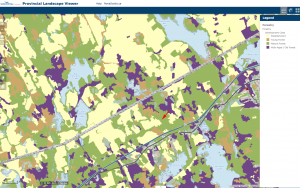
Can we heal our landscape? The image is a screen capture from the NS Provincial Landscape Viewer (Nov 19, 2019) – the pale yellow is forest recovering from clearcuts. What remains of multi-aged/Old Forest (purple) is severely fragmented. From NSFN post post: “So many clearcuts” in SW Nova Scotia (continued) 20Nov2019
Like many others who had placed some hope that L&F would actually implement the spirit of the Lahey Recommendations as well as the details, I have been dispirited by the course of events since the Lahey Report was received to the point that I now find it difficult to even read and think about L&F’s still unfolding response, let alone write about it.
L&F’s ‘High Production Forestry Discussion paper’ released on Feb 21, with responses due by March 16, 2020, did not help.
Yesterday, Addie & Fred Campaigne, residents of “high elevation (150m+) north Lunenburg county”, posted their response to the discussion paper on Stop Spraying & Clear-Cutting Nova Scotia (Public Facebook Group). It expresses the higher level concerns about losses of biodiversity and climate change that concern so many, and describes in detail the impacts that HPF would have on the local ecology and economy. It is knowledgable, thoughtful and passionate. They gave me permission to post it on NSFN. It begins:
The most concerning omission from the High Production Forestry Phase 1 – Discussion Paper is how the current species at risk and Nova Scotia’s ecosystem take priority over the lands earmarked for High Production Forestry. There are formulas to ensure nothing happens to our current large scale sawmills and forest industry, but how do we ensure the survival of our critical species at risk and guarantee continuous ecosystems for them? This paper is stating that Lands and Forests will divide up our lands to give the best to the status quo. In paragraph two of Dr. William Lahey’s executive summary he states the following:
“In other words, I have concluded that protecting ecosystems and biodiversity should not be balanced against other objectives and values as if they were of equal weight or importance to those other objectives or values. Instead, protecting and enhancing ecosystems should be the objective (the outcome) of how we balance environmental, social, and economic objectives and values in practising forestry in Nova Scotia.”
We are at this juncture in time as a direct result of past poor forestry practises. Dr. Lahey’s findings are clear and our government has agreed to implement his conclusions. This entire process of dividing up 333,000 ha of prime Nova Scotia’s forest can not happen until Nova Scotia’s forest environment is properly protected in accordance with Dr. Lahey. There is no sense dividing up land now, since proper environmental stewardship may eventually eliminate those lands from the available pool. The status quo that drives Lands and Forests is what got us to this frightening state of poor forest management. Implementing the Lahey report must begin with the biological and environmental aspects before maximum forest harvests are considered. Allow time for our biologists and environmentalist to do their job before the industrialists claim the best. The High Production Forestry as identified in the Lahey report is subservient to environmental requirements. This phase must be delayed and a new biology based phase must be embraced and completed first.
Bolding of the last 2 sentences is mine – I can only fully agree.
View the Campaignes’ full submission: Feedback High Production Forestry Phase 1 – Discussion Paper
Thanks for expressing and sharing your concerns, Addie and Fred.
——-
From Comments on this post on WWNS (Public Facebook Group)
“Lucky for the mills dnr [L&F] is handing out wood in a collapsing market”
AF: Lands and forestry is cherry picking the Lahey recommendations, the high production was to be one leg of 3.. where is the plan for land to be select cut and land to not cut? Lucky for the mills dnr [L&F] is handing out wood in a collapsing market.. how will private land owners ever see a fair price for their wood with crown handing it to Westfor
DGP: That’s a really important perspective… The whole HPF document has no reference to private lands, it’s as if it didn’t exist. Why do the big sawmills make so much fuss about any threat to harvesting on Crown lands? You have given the answer … having that supply sown up makes it easier for them to negotiate (down) the private landowners.
AF: With northern gone private land owners are in a weaker position to ask for more for there wood or better practices in the meantime dnr is doing the work to set Westfor up for the intensive leg of the triad.
AF: Lahey review recommended another review into the pay for tree planters and plantation weeding the work that is supossedly turning these clear cuts into planted high production the pay for this work was set in the 90’s and has not gone up workers in these plantations will be doing the work for to little money and Westfor control of Crown means no contractors demanding fair pay will be working on Crown
